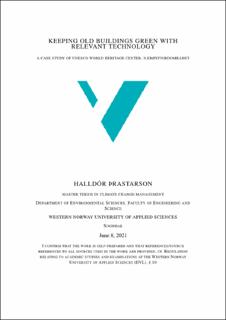| dc.contributor.author | Thrastarson, Halldór | |
| dc.date.accessioned | 2021-10-22T08:51:15Z | |
| dc.date.available | 2021-10-22T08:51:15Z | |
| dc.date.issued | 2021 | |
| dc.identifier.uri | https://hdl.handle.net/11250/2824932 | |
| dc.description | Master thesis in Climate Change Management
2021 | en_US |
| dc.description.abstract | Today the building sector accounts for around 40% of all energy used and emits around 30% of global Green House Gas (GHG) emissions. Buildings play a large role in peoples lives as we spend around 90% of our lives inside buildings. In light of these facts it is important that comfort inside buildings is kept up to standards while still reducing energy usage in buildings. This can be done by implementing Building Management Systems (BMS) to control Heating Ventilation and Air Conditioning (HVAC) systems in buildings. This study will look into the case of refurbishing a building in Aurland in Western Norway. The end goal of the project is to build a UNESCO World Heritage Center. The aim of the study is to recommend technical solutions for the building that will balance energy needs, CO2 emissions and costs. This aim can be split up into two main goals, that is finding a control method for the BMS and HVAC and then choosing the type of energy source used for the HVAC system. Three systems were studied, Air Source Heat Pump (ASHP), Water-Thermal Energy Production System (WEPS) and a conventional Electric boiler. Then several control methods were researched. The methodological part can be mainly split up to three parts. Simien was used to model the building and calculating its energy needs and efficiency. One Click LCA was used to perform a Life Cycle Assessment on the solutions and costs were estimated based on similar studies. Results showed that WEPS had the best performance based on energy usage and CO2 emissions followed shortly by the ASHP, The electrical boiler had by far the worst performance. However the electric boiler was by far the cheapest solution followed by ASHP and the the WEPS was the most expensive solution. The WEPS system was recommended for the project owner based on performance and practical pros and cons. The recommended control method for the BMS was based on research. Model Predictive Control (MPC) was the method that was chosen for this project. MPC outperforms all other control methods in most cases. MPC can reduce energy use from 15-20%. | en_US |
| dc.language.iso | eng | en_US |
| dc.publisher | Høgskulen på Vestlandet | en_US |
| dc.rights | Navngivelse 4.0 Internasjonal | * |
| dc.rights.uri | http://creativecommons.org/licenses/by/4.0/deed.no | * |
| dc.subject | Energy efficiency | en_US |
| dc.subject | Building Management System (BMS) | en_US |
| dc.subject | Heating Ventilation and Air | en_US |
| dc.subject | Conditioning(HVAC) | en_US |
| dc.subject | Life Cycle Assessment (LCA) | en_US |
| dc.title | Keeping old buildings green with relevant technology: A case study of UNESCO World Heritage Center, Nærøyfjordområdet | en_US |
| dc.type | Master thesis | en_US |
| dc.description.localcode | GE4-304 | en_US |

